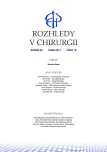Clostridium difficile remains a medical challenge
Authors:
O. Nyč; M. Krůtová
Authors‘ workplace:
Ústav lékařské mikrobiologie FN v Motole, Praha
přednosta: prof. MUDr. P. Dřevínek, Ph. D
Published in:
Rozhl. Chir., 2017, roč. 96, č. 10, s. 411-414.
Category:
Review
Overview
Intestinal infections caused by the Clostridium difficile (CDI) bacterium currently represent a serious medical problem. They belong to the most frequent nosocomial infections and, in some countries, a community-acquired disease with a significantly increased incidence of community associated CDI is reported. The infection can manifest as mind diarrhea, but also as a life-threatening illness accompanied by paralytic ileus and painful distension of the colon, developing into secondary sepsis. Recurrent forms difficult to manage are a relatively common complication of the disease. Severity of infection may be influenced by the virulence of the causative strain. Severe course of the disease is associated with ribotypes 027, 078, 001. In the Czech Republic, ribotypes 001 and 176 have predominated over the last years. Laboratory diagnosis is based on the detection of C. difficile glutamate dehydrogenase and free clostridium toxins (A,B) in a diarrheal stool sample or culture of C. difficile in anaerobic conditions.
Metronidazole, vancomycin and fidaxomicin are the drugs of choice in the treatment of aC. difficile with administration according to the actual treatment guidelines. Fecal bacteriotherapy is recommended in treatment and prevention of recurrent CDI. Surgery is indicated in progressive complicated forms when no response to medication is achieved and the patient is in a critical condition.
Key words:
Clostridium difficile − intestinal infection − epidemic ribotypes − clostridium colitis treatment
Sources
1. Bartlett JG, Gorbach SL. Pseudomembranous enterocolitis (antibiotic-related colitis).Adv Intern Med 1977;22 : 455–76.
2. Krutova M, Nyc O, Matejkova J, et al. Molecular characterisation of Czech Clostridium difficile isolates collected in 2013–2015. Int J Med Microbiol 2016;306 : 479–85.
3. Ziakas PD, Zacharioudakis IM, Zervou FN, et al. Asymptomatic carriers of toxigenic C. difficile in long-term care facilities: a meta-analysis of prevalence and risk factors. PLoS One 2015. Available from: https://doi.org/10.1371/journal.pone.0117195.
4. Gerding DN, Lessa FC. The epidemiology of Clostridium difficile infection inside and outside health care institutions. Infect Dis Clin North Am 2015;29 : 37–50.
5. Krutova M , Matejkova J, Kuijper EJ, et al. Czech Clostridium difficile Study Group. Clostridium difficile PCR ribotypes 001 and 176 – the common denominator of C. difficile infection epidemiology in the Czech Republic, 2014. Euro Surveill 2016. Available from: doi: 10.2807/1560–7917.
6. Bauer MP, Notermans DW, van Benthem BH, et al. Clostridium difficile infection in Europe: a hospital-based survey. Lancet 2011;377 : 63–73.
7. Davies KA, Longshaw CM, Davis, et al. Underdiagnosis of Clostridium difficile across Europe: the European, multicentre, prospective, biannual, point-prevalence study of Clostridium difficile infection in hospitalised patients with diarrhoea (EUCLID). Lancet Infect Dis 2014;14 : 1208–19.
8. Krutova M, Matejkova J, Nyc O. C. difficile ribotype 027 or 176? Folia Microbiol 2014;59 : 523–6.
9. Ong GK, Reidy TJ, Huk MD, et al. Clostridium difficile colitis: A clinical review. Am J Surg. 2017;213 : 565–71.
10. Beneš J, Husa P, Nyč O, et al. Doporučený postup diagnostiky a léčby kolitidy vyvolané Clostridium difficile. Klin Mikrobiol Infekc Lek 2014;20 : 56–66.
11. Debast SB, Bauer MP, Kuijper EJ. European Society of Clinical Microbiology and Infectious Diseases: update of the treatment guidance document for Clostridium difficile infection. Clin Microbiol Infect 2014;20Suppl 2 : 1–26.
12. Kelly CP. Can we identify patients at high risk of recurrent Clostridium difficile infection? Clin Microbiol Infect 2012;18,Suppl 6 : 21–7.
13. Drabek J, Nyc O, Krutova M, et al. Clinical features and characteristics of Clostridium difficile PCR-ribotype 176 infection: results from a 1-year university hospital internal ward study. Ann Clin Microbiol Antimicrob 2015;14 : 55.
14. Polivkova S, Krutova M, Petrlova K, et al. Clostridium difficile ribotype 176 – A predictor for high mortality and risk of nosocomial spread? Anaerobe 2016;40 : 35–40.
15. Crobach MJ, Planche T, Eckert C, et al. European Society of Clinical Microbiology and Infectious Diseases: update of the diagnostic guidance document for Clostridium difficile infection. Clin Microbiol Infect 2016;22 Suppl 4:S63–81.
16. Venugopal AA, Johnson S. Fidaxomicin: a novel macrocyclic antibiotic approved for treatment of Clostridium difficile infection. Clin Infect Dis 2012;54 : 568–74.
17. Polák P, Freibergerová M, Husa P, et al. Fekální bakterioterapie v léčbě rekurentní kolitidy způsobené Clostridium difficile na klinice infekčních chorob fakultní nemocnice Brno v letech 2010–2014 – prospektivní studie. Epidemiol Mikrobiol Imunol 2015;64 : 232–5.
18. Martin J, Wilcox M. New and emerging therapies for Clostridium difficile infection. Curr Opin Infect Dis. 2016;29 : 546–54.
19. Bartlett JG. Bezlotoxumab – A new agent for Clostridium difficile infection. N Engl J Med 2017;26;376 : 381–2.
20. Kokai-Kun JF, Roberts T, Coughlin O, et al. The oral β-lactamase SYN-004 (Ribaxamase) degrades ceftriaxone excreted into the intestine in phase 2a clinical studies. Antimicrob Agents Chemother 2017;23 : 61.
Labels
Surgery Orthopaedics Trauma surgeryArticle was published in
Perspectives in Surgery

2017 Issue 10
Most read in this issue
- Complicated intraabdominal infections in surgical patients–empiric antimicrobial therapy management
- Clostridium difficile remains a medical challenge
- Bleeding during anticoagulant and antiaggregation therapy as a cause of acute abdomen
- Treatment of locally advanced rectal cancer – is it time for a change?
